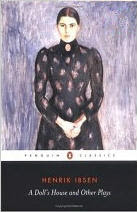 In A Doll’s House, perhaps the most famous - and at the time, most scandalous - of Ibsen’s plays - the doll is Nora Helmer. Indulged by her husband, who treats her as a decorative and none-to-bright ornament, she has concerns which he knows nothing about. When scandal threatens the family, the doll finally decides to think for - and of - herself. The League of Youth is a political comedy in which the charismatic Stensgard throws himself into local political manoeuvring, beginning with the founding of the League. But before the campaigning can get underway, the characters end up at increasingly tangled cross-purposes. And in The Lady from the Sea, a mystery form as the past comes back to haunt Ellida Wangel, who grew up on an island and cannot bear to be far from the ocean.
In A Doll’s House, perhaps the most famous - and at the time, most scandalous - of Ibsen’s plays - the doll is Nora Helmer. Indulged by her husband, who treats her as a decorative and none-to-bright ornament, she has concerns which he knows nothing about. When scandal threatens the family, the doll finally decides to think for - and of - herself. The League of Youth is a political comedy in which the charismatic Stensgard throws himself into local political manoeuvring, beginning with the founding of the League. But before the campaigning can get underway, the characters end up at increasingly tangled cross-purposes. And in The Lady from the Sea, a mystery form as the past comes back to haunt Ellida Wangel, who grew up on an island and cannot bear to be far from the ocean.
As it turned out, the plays appeared in the book in reverse order of preference. First was The League of Youth - more politics! I can’t think, offhand, of any author who’s managed to make politics interesting, and Ibsen was no exception. The more farcical aspects of the plot were amusing, but it’s telling that I had to check the book to remind myself of the main character’s name. A Doll’s House won me over by the end with a fine appeal to my feminist instincts, but it took me a while to warm up to it. Yes, Torvald Helmer was a bit of a jerk who treated his wife like a child; but she let him do it and happily played along with his infantilisation of her. She also struck me as silly and spendthrift, and even though she found a backbone I still had doubts about her ability to survive on her own. My favourite was The Lady from the Sea. I like a bit of a mystery, although this one didn’t end the way I thought it would (I think I’ve read too many ghost stories).
Rating: B











1 comment:
I had to read A Doll's House for an introductory literature class 2 years ago and like you, I found Nora such a child-like (childish maybe?) character I highly doubt she can survive on her own out there, especially during that time in society. And since plays written during that time still ascribe to the maxime of having all action within a 24-hour span, we see this huge change in attitudes and feelings from the beginning to the end. Frankly speaking, I didn't like it at all, but on the account that it's one of the first few plays that give women a voice, it's passable I guess.
Post a Comment